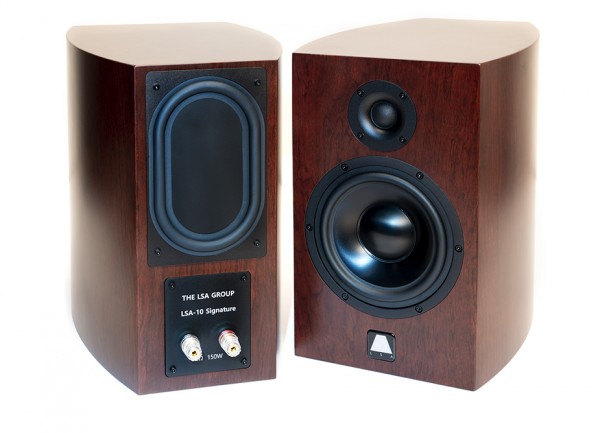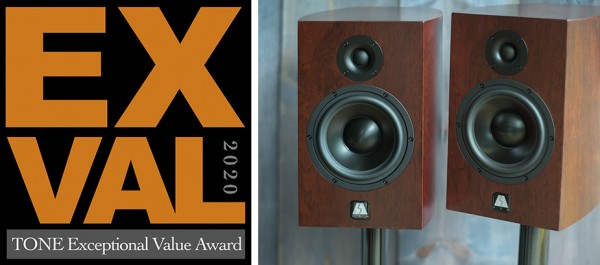The LSA-10 Signature Speakers Big Voice, Small Speakers
By Jeff Dorgay Serious listening with the LSA-10 Signature speakers begins with a quick dial back on the way back machine, all the way to 1965 and some Gabor Szabo.
Serious listening with the LSA-10 Signature speakers begins with a quick dial back on the way back machine, all the way to 1965 and some Gabor Szabo.
If you aren’t familiar, this Hungarian guitarist was quite the rage back in the day, with a clean style that remindsme a lot of Johnny Smith or Kenny Burrell. Szabo’s playing quickly showcases the coherence displayed by this 2 1/2 way design from LSA. With a 6.5-inch woofer and soft dome tweeter on the front face, and a 5×7 inch passive radiator facing rearward, this “bookshelf” design might just fool you into thinking it’s a floorstander with your eyes closed. The transition from the lowest bass notes all the way up to the top of the frequency spectrum has this Quad loving audio enthusiast nodding in approval. And as your favorite 80s game show host might say, “what would you expect to pay for speakers offering this kind of performance?” The Signature model reviewed here is now only $1,495/pair.
The $3,495 Statement model is the same, except for a beryllium dome tweeter. If you want a bit more resolution and a harder edge to the sonic picture painted, pony up for the Statements. This part will be strictly personal preference and related ancillaries. Underwood Wally (the man behind distributor Underwood HiFi) will probably be angry with me for loving the lower-priced model. Still, I confess to almost always preferringthe sound of a silk dome tweeter. Bias exposed. While I’m making enemies – throw out the perforated metal grille while you’re at it. (or put it back in the box for another day) The rest of the fit and finish would be better served by a well-executed fabric grill, or something with a finer perforation, more like what MartinLogan does. I’m guessing most of you listen without grilles, so this is really no big deal.
Running the gamut
LSA doesn’t specify sensitivity on these speakers, but even the low powered Pass Labs INT25 integrated (25wpc, pure Class-A) offers more than enough power and control to drive these speakers to a high level in my 13 x 18-foot living room. While several different tube and solid-state amplifiers were given a go with the LSA-10 Signatures, they are not at all difficult to drive. After trying about a dozen different combinations, most listening was done with the PrimaLuna EVO400 power amplifier (85wpc, tubes) in concert with the Backert Labs Rhumba preamplifier and Gold Note DS10 DAC/Streamer, with a bit of vinyl on the side. 95% of the source music used was via Roon and Qobuz. The EVO400 proved to have more than enough drive and smoothness that really compliments the LSA-10s. As with the tweeter choice, those wanting a slightly more forward sound might prefer a non-Class-A solid-state amplifier.
The Hegel 590 is in for review, and this amplifier offers up a punchier, more forward presentation. Substituting the Hegel for the CJ/PrimaLuna combo feels like moving up from row 20 to row 8 in the auditorium. I like the soft dome tweeter; those wanting a bit more aggressive overall sound have more options than a speaker with a tweeter that’s already a little forward. But we can argue about this all day long; let’s get back to listening to music!
Splitting hairs
Just as the line between prince and frog can be thinner than you think, the same applies whether you consider a speaker smooth or laid back. After listening to the LS-10s for some time, I’m still going with smooth. For my money, laid back feels more like a loss of resolution, especially in the upper registers, and the LS-10s do not fall victim to this. Listening to more acoustic music illustrates that cymbals dither into nothingness with plenty of detail, and stringed instruments have the required amount of body to feel realistic. Like nearly all speakers relying on a soft dome tweeter, there is a slight softening of the hardest transients, such as drum heads and the initial strike of piano keys.
A long playlist of hard-rocking tunes clearly proves that the LS-10s ability to move air. That rear-firing passive radiator goes a long way to make these speakers feel like floorstanders. When playing material with heavy bass content (Kruder andDorfmeister, Pink Floyd, Massive Attack, that kind of thing), these compact speakers demonstrate significant authority. In addition to delivering substantial low-frequency information, the quality of what is produced is excellent. Stanley Clarke has been in heavy rotation here lately and tracking through If This Bass Could Talk, proves the LS-10s more than capable.
Setup
Those rear-firing passive radiators will require a bit more time to ace the setup, but your efforts will be rewarded. I suggest starting about a foot further out in your room than what you might be used to with other speakers lacking a rear driver or passive radiator. As always, the key is going to be adjusting around the bass presentation you want, and then adjusting the rest with toe-in and rake angle.
Using a pair of filled 24″ Sound Anchor stands with a bit of sticky stuff to improve the speaker/stand interface works like a charm. Small monitors always need great stands to deliver the most solid bass response, and these perhaps a bit more, because they go down further than many of the other small monitors we’ve used.
The LS-10s do not produce a stereo image that goes well beyond the speaker edges, so adjust speaker width, and toe-in with care. The more time you spend on this aspect of setting them up will produce the largest stereo image they are capable of. What these speakers lack in the last few molecules of stage width and pin-point imaging, is more than made up forin natural tonality and lifelike sonics. Every speaker has design compromises, and they’ve made solid choices here. That devil personal bias sets in again, but I’d much rather have a coherent speaker with a natural midrange over a speaker that produces a mile wide stereo image, yet falls flat on tonality.
A major contender
Trying to stay more in tune with those not wanting a six-figure hifi system, yet still craving a great musical experience, we’ve been auditioning more speakers in this price range, and we all agreed that the LSA LS-10s would be on our top five list if we actually did that kind of thing. It’s not often that a $1,495 pair of speakers do this much right tonally and offer an excellent sense of scale too. Those needing more oomph can step up to the LS-20 floorstanders or add a pair of subs to the LS-10s.
Balance and nuance will always be my catnip, and this is something the LS-10 Signatures excel at. I can’t imagine a better choice in the context of a $5k – $15k system. Different, yes, but in terms of sheer sonic quality, these are awfully impressive. The design choices by the LSA team havemade serve the music. I am very happy to give the LS-10s an Exceptional ValueAward for 2020.



